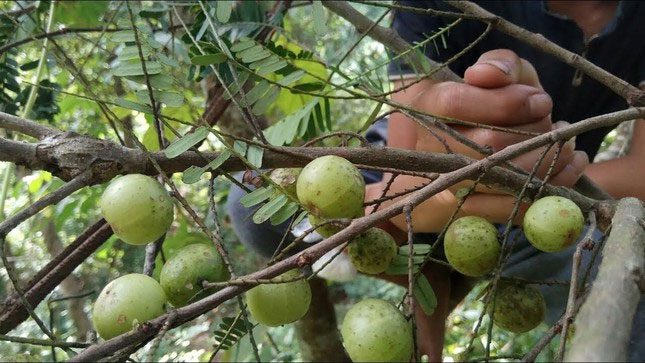According to scientists from the Institute of Natural Compounds Chemistry (Vietnam Academy of Science and Technology), wild tamarind, also known as Mak Kham, mountain tamarind, wild plum, Duy cam tu, Dieu cam, and Xi la lien, is a wild-growing tree that is commonly found in provinces such as Hoa Binh, Son La, Cao Bang, and Bac Kan in northern Vietnam.
Wild tamarind bears a high yield, with production reaching from several dozen to several hundred kilograms of fresh fruit per tree. This species can grow from small to medium size, reaching heights of 10-18 meters. It has a gray-green bark and yellow-green flowers that grow in clusters. The leaves are about 40 cm long, spreading out to form a flat surface. The bark becomes brown and flakes off. The leaves are hairless, measuring only 3 mm in width and 1.25 – 2 cm in length. The immature fruit is light green, turning brick red when ripe, with a diameter of 1.8 – 2.5 cm.

Wild tamarind has many health benefits. (Photo: Internet).
Globally, wild tamarind is an important ingredient in traditional detoxification and digestive remedies, widely used in Ayurvedic and Unani traditional medicine. According to ancient Ayurvedic texts, such as Charaka Samhita and Sushruta Samhita, wild tamarind is considered one of the best sour fruits.
In Vietnam, wild tamarind is known to enhance calcium absorption, prevent cramps during menstruation, treat diabetes, promote digestion, and manage high blood pressure. In addition to these benefits, wild tamarind is also used as a remedy to reduce fever, support liver disorders, treat indigestion, anemia, urinary issues, respiratory difficulties, act as a diuretic, combat infections, boost the immune system, combat skin aging, improve appetite, and assist in healthy weight gain.

Vietnamese scientists have successfully researched the extraction process to create products from wild tamarind that protect the liver.
Research results in chemistry have shown that wild tamarind is rich in phenolic compounds, which have strong antioxidant properties, enhance lipid metabolism, reduce blood lipids, lower cholesterol, and protect the liver. According to scientists, in recent years, phenolic compounds have become a focus of research and application in health and nutrition due to their strong antioxidant activity and ability to combat free radicals during metabolism, resist cancer, and prevent cardiovascular and various chronic diseases.
In light of the remarkable benefits of wild tamarind, scientists at the Institute of Natural Compounds Chemistry, Vietnam Academy of Science and Technology, have undertaken a project to develop technology: “Research on the liver-protective effects of wild tamarind with the aim of studying its chemical composition and evaluating its biological effects, creating products to support liver disease treatment.” The project has successfully developed a technology extraction process to create products from wild tamarind that exhibit antioxidant effects and provide liver protection.


















































